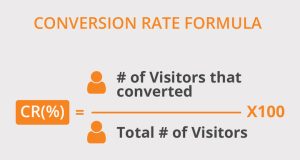Why is CRO not a Choice anymore? (It is Necessary)

CRO is no longer a BUZZWORD.
EVERY COMPANY ON THE DIGITAL PLATFORM IS TALKING ABOUT IT. However, many people are still confused or misinformed.
We frequently get questions like, “Is it a marketing gimmick?” Is this necessary? Do start-ups require it as well? Isn’t it just for eCommerce stores? Is there something we’re missing if we don’t follow it?
… and many more.
The purpose of this blog post is to provide concise answers to each of these questions.
I’ll begin by responding.
What exactly is CRO?
Conversion Rate Optimization is abbreviated as CRO.
Conversion, in the context of a website, refers to the process by which our website visitors complete the desired action. The action that we or any other business would want them to take to become customers. It could be email sign-up, product purchase, lead generation, and so on.
As the name implies, it is used to improve website conversion rates. Simply put, optimization is the process of increasing the rate at which visitors to your website convert to customers.
But
How you will calculate Conversion Rate (CR)?
Conversion rate is the percentage of visitors to your website or landing page that take the desired action. To calculate it, you need to divide the number of conversions (or desired actions taken) by the total number of visitors.

For example, let’s say you have 10,000 visitors per month on your blog and 150 new email subscribers monthly. This means your email sign-up conversion rate is 1.5% (150 / 10,000).
It’s important to track your conversion rate over time. By doing so, you can see how your campaigns and strategies are performing and make changes when needed. By understanding your conversion rate and taking steps to improve it, you can ensure that your website and campaigns are performing at their best.
Knowing the average conversion rate for your industry can help you set realistic goals for your own business and compare your performance to the competition.
So, What is the Average Conversion Rate? Unfortunately, there is no one-size-fits-all answer to this question. Conversion rates can vary greatly depending on factors such as the industry, the type of product or service being offered, and the quality of the marketing efforts.
However, some industry averages can be used as a benchmark. According to Wordstream, the average conversion rate across all industries is 2.35%.
The eCommerce industry tends to have higher conversion rates than other industries. On average, eCommerce stores have a conversion rate of around 2.86%. This is because customers are typically more familiar with the buying process on an eCommerce website, making it easier to complete the purchase.
It’s important to note that the average conversion rate is just a benchmark. It’s not a definitive measure of success; rather, it’s meant to be used as a starting point for setting goals.
It’s more important to increase your current conversion rate – Never Stop Improving!
The question now is,
“How does the CRO process work?”
Each website has some text and visual components that visitors can interact with to convert. The process of measuring these interactions to comprehend the behaviour of your target audience, identify their objections, and develop a methodical, step-by-step strategy to get past those objections in order to boost business performance and the bottom line is known as Conversion Rate Optimization (CRO).
CRO is a scientific process that consists of the following phases:
- Setting up Goal – The first step in a successful CRO campaign is to set up goals for the program. Proper goal setting is essential for figuring out which metrics to measure, identifying relevant KPIs, and implementing strategies that will yield the best results. When setting goals for your CRO program, it’s important to ensure they are SMART: Specific, Measurable, Attainable, Relevant and Time-Specific.
- Researching Customer Behavior in Preparation for Testing Ideas –A crucial part of creating a successful CRO program is understanding customer behaviour and needs. To do so, businesses need to research what customers are looking for and analyze the data collected from existing sources. There are numerous tools and techniques available to help you gain a thorough understanding of your visitors and how they interact with your website. By doing so, you’ll be able to empathise with them and determine the precise reason why they aren’t becoming consumers. The purpose is to identify any points of misunderstanding, friction, or discontent that could be improved through optimization.
- Creating Hypotheses Based on Research Findings and Test Them Out with Experiments- Once businesses have a better understanding of their target audience, they can develop hypotheses regarding how they can improve their conversion rate. This step involves changing different elements of the website while running split tests to measure the performance difference between variants.
- Analyzing Results From Experiments and Making Adjustments as Needed- After running split tests, businesses will have access to data that can help them make informed decisions regarding how to improve their conversion rate. This last step involves examining how different variants performed by looking at key performance indicators, such as clicks, impressions, conversions and more. Depending on the results obtained, businesses will have to refine their strategies accordingly.
A well-planned CRO program is based on setting SMART goals, researching customer behaviour, testing different ideas, analyzing data and making adjustments where necessary. With the right approach, businesses can efficiently increase their conversion rates and generate more leads and conversions from their target audience.
It’s important to remember that CRO is an ongoing process. As your website evolves, you should continue to test and measure the results of any changes you make. This process takes time, but it can result in significant increases in conversions, which can be extremely beneficial to businesses.
But wait,
Who can benefit from a CRO program?
Regardless of industry, the CRO program can benefit companies of all sizes, from small businesses to large corporations because, as customers are the lifeblood of every business, knowing more about them can help you serve them more effectively.
CRO program provides valuable insight into customer engagement with your website and enables businesses to optimize the user experience and improve website performance, thus helping them to convert more visitors into customers, increase their sales and revenue, and improve their brand awareness.
Now, it’s time to go back to the post’s opening query and provide a response.
Why is CRO not a Choice anymore?
With the ever-increasing competition in the digital space, businesses need to make sure they are doing everything they can to maximize their conversion rate.
Here are some of the reasons why CRO is not a choice anymore:
- It Increases Your ROI: By boosting your conversion rate, CRO enables you to get the most out of your marketing initiatives. This implies that you will be able to increase your lead and customer counts while maintaining your marketing budget.
- It Helps You Stay Ahead of the Competition: With the use of CRO, you can spot areas on your website that could use better and make the necessary adjustments. By doing this, you can ensure that you are providing the finest customer experience while also staying one step ahead of the competition.
- It Improves User Experience: CRO helps you to identify areas of improvement on your website that can help improve the user experience. This includes making sure that the website is easy to navigate, the content is relevant and engaging, and the overall design is attractive.
- It Helps You Reach Your Goals: CRO helps you to identify areas of improvement on your website that can help you reach your goals. This includes increasing the number of leads and customers, improving the quality of leads, and increasing the average order value.
- Improved Customer Retention: CRO can help you improve customer retention by providing a better user experience. By understanding user behaviour and making changes that improve the user experience, you can increase the likelihood of customers returning to your website.
Conversion rate optimization programs are essential for any business that wants to make the most out of its online presence and maximize the potential of its website. By implementing CRO strategies, businesses can ensure that they are offering the best user experience possible and reaching their goals.
You’ve put a lot of effort and money into building your website and bringing traffic to your website. Now it’s time to bring more conversions!